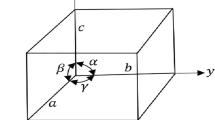Abstract
Single crystals of MoSi2 and WSi2 with a body-centred-tetragonal C 1 1b structure were fabricated using a floating-zone method. The elastic wave velocity was measured for samples with various orientations using a simple pulse echo method at room temperature, and six elastic stiffness constantsc ij were calculated. The stiffness constants were a little higher for WSi2 than for MoSi2.c 11 andc 33 of these compounds were approximately equal toc 11 of tungsten and molybdenum, respectively, althoughc ij (i ≠j) was a little higher for these compounds than for molybdenum and tungsten. Young's modulus 1/s 11 was the highest in the <0 0 1> direction, and the lowest in the <1 0 0> direction. The shear modulus 1/s 66 was high on the {0 0 1} plane and independent of shear direction. It was generally low on the close-packed {1 1 0} plane and largely dependent on shear direction. The elastic constants for the polycrystalline materials were estimated fromc ij ands ij . Poisson's ratiov was 0.15 for MoSi2 and for WSi2, and these values were much lower than for ordinary metals and alloys. The Debye temperature θD was estimated using the elastic-wave velocity of the polycrystalline materials via the elastic constants such as Young's modulus and shear modulus: it was 759 K for MoSi2 and 625 K for WSi2.
Similar content being viewed by others
References
A. B. Gokhale, G. J. Abbaschain, R. W. Olesinski andG. J. Abbaschian, in Binary Alloy Phase Diagrams, vol. 2, T. B. Massalski (editor) (ASM, Ohio, 1986) pp. 1631, 2062.
G. V. Samsonv andI. M. Vinitskij (editor) Tvgoplavkie Soedineniya (High-melting Compounds) (1976) Ch. 5, Moskva, “Metallurgiya”, (Japanese translation). p. 287.
K. Tamura,J. Jpn Soc. Powder Powder Metall. 8 (1960) 113 (in Japanese).
O. Thomas, J. A. Senateur, R. Madar, O. Laborde andE. Rosencher,Solid State Commun. 55 (1985) 629.
JCPDS Powder Diffraction File, Inorganic Volume, No. 5-749, No. 11-195 (JCODS International Centre for Diffraction Data, Pennsylvania, USA).
C. J. Smithells (editor) Elastic properties and damping capacity, in “Metals Reference Book”, 5th edn (Butterworths, London, Boston, 1976) p. 975.
A. E. H. Love, “A Treatise on the Mathematical Theory of Elasticity” 4th edn (Dover, New York, 1944) p. 100.
O. L. Anderson,J. Phys. Chem. Solids 24 (1963) 909.
C. Kittel, “Introduction to Solid State Physics” 5th edn (Wiley, New York, 1976) p. 118 (Japanese translation).
Author information
Authors and Affiliations
Rights and permissions
About this article
Cite this article
Nakamura, M., Matsumoto, S. & Hirano, T. Elastic constants of MoSi2 and WSi2 single crystals. J Mater Sci 25, 3309–3313 (1990). https://doi.org/10.1007/BF00587691
Received:
Accepted:
Issue Date:
DOI: https://doi.org/10.1007/BF00587691




